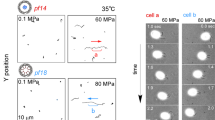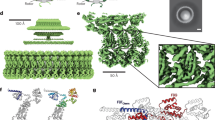Abstract
SEVERAL recent findings1–3 suggest that the intracellular concentration of free calcium, [Ca]i, has an important role in the regulation of ciliary and flagellar beating. For example, Paramecium extracted with Triton X-100 and reactivated with Mg2+ and ATP swim backwards when the Ca2+ concentration of the test medium, [Ca]0, is raised above 10−6M (ref. 1). Similarly, extracted cells of the typanosomid Crithidia show a reversal in wave propagation that is controlled by Ca ions. In studies on the intact flagellar apparatus isolated from a wall-less mutant of Chlamydomonas reinhardtii, the flagella have been shown to reverse direction of the effective stroke when external [Ca]o is raised above 10−6 M (ref. 3). Electro-physiological evidence indicates that, in Paramecium, reversal of ciliary beating is caused by Ca which enters the cell when the Ca permeability of the membrane is increased4,5. We have investigated whether Ca is involved in the phototactic response and more specifically whether this Ca influx is regulated by the cell membrane. Electrophysiological recording was impractical because of the small size of these cells (< 10 µm), and so the approach was to photograph the light-induced motor responses of cells swimming in solutions containing different concentrations of Ca or Ca-blocking agents. The results demonstrate that the reversed beating response of the flagella depends on Ca. Inhibition of the response by Ca-blocking agents supports the view that reversed beating response of the flagella is coupled to photostimulation by an influx of Ca ions.
This is a preview of subscription content, access via your institution
Access options
Subscribe to this journal
Receive 51 print issues and online access
$199.00 per year
only $3.90 per issue
Buy this article
- Purchase on Springer Link
- Instant access to full article PDF
Prices may be subject to local taxes which are calculated during checkout
Similar content being viewed by others
References
Naitoh, Y., and Kaneko, H., Science, 176, 524–532 (1972).
Holwill, M. E., and McGregor, J. L., Nature, 255, 157–158 (1975).
Hyams, J. S., and Borisy, G. G., J. Cell Biol., 67, 186 (1975).
Eckert, R., Science, 176, 478–481 (1972).
Eckert, R., Naitoh, Y., and Machemer, H., Symp. Soc. exp. Biol., 30 (edit. by Duncan, C.), (Academic, London, 1976).
Sueoka, N., Proc. natn. Acad. Sci. U.S.A., 46, 83–91 (1960).
Portzehl, H., Caldwell, P. C., and Ruegg, J. C., Biochim. biophys. Acta, 79, 581–591 (1964).
Ringo, D. L., J. Cell Biol, 33, 543–571 (1967).
Ulehla, V., Biol. Zbl., 31, 696–701 (1911).
Fleckenstein, A., Tritthart, H., Fleckenstein, B., Herbst, A., and Grüm, G., Pflügers Arch. ges. Physiol., 307, 25 (1969).
Seeman, P., Pharmac. Rev., 14, 583–655 (1972).
Blaustein, M. P., and Goldman, D. E., J. gen. Physiol, 49, 1043–1063 (1966).
Hagiwara, S., in Membranes, 3 (edit. by Eisenman, G.), 359–378 (Dekker, New York, 1975).
Naitoh, Y., Eckert, R., and Friedman, K., J. exp. Biol, 56, 667–681 (1972).
Friedman, K., and Eckert, R., Comp. Biochem. Physiol., 45 A, 101–114 (1973).
Author information
Authors and Affiliations
Rights and permissions
About this article
Cite this article
SCHMIDT, J., ECKERT, R. Calcium couples flagellar reversal to photostimulation in Chlamydomonas reinhardtii. Nature 262, 713–715 (1976). https://doi.org/10.1038/262713a0
Received:
Accepted:
Issue Date:
DOI: https://doi.org/10.1038/262713a0
This article is cited by
-
Gating and ion selectivity of Channelrhodopsins are critical for photo-activated orientation of Chlamydomonas as shown by in vivo point mutation
Nature Communications (2022)
-
Adhesion of Chlamydomonas microalgae to surfaces is switchable by light
Nature Physics (2018)
-
How 5000 independent rowers coordinate their strokes in order to row into the sunlight: Phototaxis in the multicellular green alga Volvox
BMC Biology (2010)
-
Die Orientierung freibeweglicher Organismen zum Licht, dargestellt am Beispiel des FlagellatenChlamydomonas reinhardtii
Naturwissenschaften (1994)
-
Rhodopsin-regulated calcium currents in Chlamydomonas
Nature (1991)
Comments
By submitting a comment you agree to abide by our Terms and Community Guidelines. If you find something abusive or that does not comply with our terms or guidelines please flag it as inappropriate.



